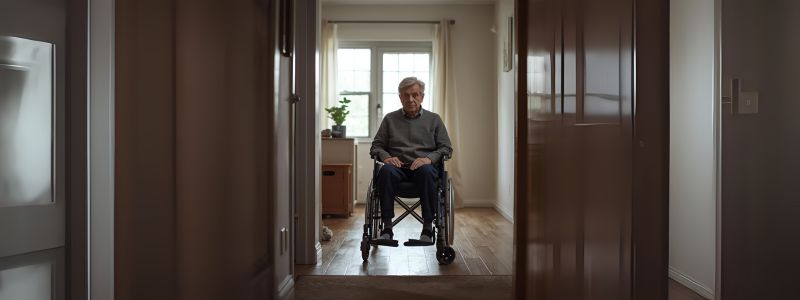
Noticing small changes in your parents’ daily habits can be a key indicator that their care requirements are shifting. While a vast majority of adults over 50 wish to remain in their own homes, many families overlook early signals that could prevent accidents and hospital visits.
This guide will help you identify key indicators of changing care needs, covering physical health, cognitive changes, emotional well-being, and home safety risks. We’ll connect each sign to practical steps for assessment and support. You’ll discover:
- Early indicators across physical, cognitive, behavioral, environmental, and financial aspects
- Methods for assessing mobility, personal care, nutrition, and medication management
- Crucial cognitive and emotional signs like memory lapses, judgment issues, mood shifts, and social withdrawal
- Home safety red flags such as clutter, accidents, and maintenance oversights
- Triggers for seeking help, exploring care options through Find Care – AgeWell Now, and the value of a care-needs assessment
- Helpful tools and checklists, including a top-10 signs list, to simplify your caregiving journey
By linking these indicators to practical solutions and relevant resources, you’ll gain the confidence to recognize and address evolving care needs with both empathy and expertise.
First Signs an Elderly Parent Might Need More Help
Early indicators are a combination of physical, cognitive, behavioral, environmental, and financial signals that paint a complete picture of diminishing independence. Recognizing these signs early allows for timely intervention before serious issues arise.
The National Institute on Aging points out several critical signs that suggest an older adult might need additional assistance. These include changes within their living space, such as difficulties with keeping the home tidy, preparing meals, or managing medications. Other important cues involve mental health concerns like shifts in mood or signs of depression, feelings of loneliness or isolation, mobility challenges, and noticeable memory problems.
This reference provides a thorough and credible overview of common indicators across physical, cognitive, behavioral, and environmental areas, aligning perfectly with the article’s detailed guidance on recognizing changing care needs.
Physical Changes Suggesting Declining Health
A decrease in strength and coordination often shows up as changes in mobility, balance issues, and reduced stamina.
- Frequent stumbles or an unsteady walk suggest balance problems that increase the risk of falls.
- Difficulty getting up from a chair or climbing stairs points to weakness in the lower body and decreased muscle strength.
- Noticeable tiredness during regular walks indicates a decline in cardiovascular or musculoskeletal function.
Falls and reduced mobility significantly affect daily life and independence. Identifying these changes naturally leads to evaluating personal care needs and making home adjustments to ensure safe movement.
Spotting Cognitive Decline and Memory Loss
Memory lapses that disrupt daily life—like forgetting appointments or misplacing essential items—can signal the onset of cognitive impairment. Confusion about the date, location, or familiar people further suggests potential conditions like dementia, which warrants early medical attention. Observing repeated questions, lost belongings, and difficulty following conversations helps you connect memory loss to structured cognitive support strategies.
Behavioral and Emotional Shifts to Look For
Sudden mood swings, unexplained irritability, and episodes of heightened anxiety often accompany declining health or social isolation.
- Consistent lack of interest or withdrawal from hobbies and social activities typically points to depression.
- Increased frustration or sudden anger may stem from limitations imposed by physical challenges.
- Heightened worry about leaving home can indicate a fear of falling or confusion.
Home Environment and Safety Issues Signaling Care Needs
A home that is increasingly cluttered or poorly maintained can reveal growing difficulties with housekeeping, organization, or a lack of motivation. Poor lighting, obstructed pathways, and malfunctioning appliances increase the risk of accidents and highlight the need for home safety improvements and support services.
Financial and Administrative Signs Suggesting a Need for Help
Missed bill payments, unopened mail, or unusual spending habits often indicate challenges with executive function or memory. Financial mismanagement can expose seniors to scams and debt, underscoring the necessity of administrative assistance or legal arrangements to protect their finances and ensure timely bill payments.
Evaluating Physical Health Indicators of Changing Care Needs

Assessing physical indicators involves careful observation, standardized tests, and structured checklists focusing on mobility, personal hygiene, nutrition, and medication adherence.
Common Mobility and Balance Issues
Simple tests like the Timed Up-and-Go (TUG) and chair stand tests can measure balance and strength. Observing a shuffling gait, reliance on furniture for support, and a fear of falling signals the need for physical therapy or in-home assistance. Documenting these observations provides a clear baseline for tracking progress or further decline.
Recognizing Poor Personal Hygiene and Grooming
Infrequent showering, unkempt nails, dirty clothing, or body odor suggest a reduced ability or motivation for self-care. Regularly check grooming habits: neglected dental care or skipped hair washing often reflects physical difficulties or cognitive lapses. These observations point to the need for personal care services to maintain dignity and health.
Nutrition and Weight Changes Indicating Care Needs
Unexplained weight loss or gain, spoiled food in the refrigerator, and skipped meals signal problems with managing nutrition effectively.
The following table connects important nutrition indicators with their implications:
| Indicator | Observation | Care Implication |
|---|---|---|
| Unexplained weight loss | Clothes fitting loosely over weeks | May require a referral to a dietitian and assistance with meal preparation |
| Frequent spoiled perishables | Half-eaten or expired food in the kitchen | Suggests the need for help with weekly grocery shopping |
| Loss of appetite or overeating | Changes in regular meal patterns | Indicates a need to evaluate metabolism or mood |
These patterns warrant close monitoring of food intake and consideration of meal delivery services or companion care to ensure balanced nutrition. Proper eating habits contribute to better energy levels, a stronger immune system, and overall well-being.
Detecting Medication Management Challenges
Missed doses, taking duplicate doses, and using expired prescriptions create significant health risks. Implementing a pill organizer and tracking adherence with a written log can clarify whether professional medication management or electronic reminders are necessary. Consistent medication routines are crucial for reducing hospitalizations and improving treatment effectiveness.
Key Cognitive Health Indicators of Declining Care Needs
Cognitive health assessments focus on memory, judgment, and communication abilities that impact a senior’s safety and independence.
Spotting Memory Loss and Confusion
Forgetting recent conversations, repeatedly asking the same question, or wandering away from home are signs of memory impairment. Use simple recall questions—like asking about their meal yesterday—and note any difficulty retrieving information. Early detection can lead to memory support programs and cognitive therapies that may slow progression and help maintain daily living skills.
Signs of Impaired Judgment and Decision-Making
Poor financial decisions, falling for scams, or unrealistic planning reflect changes in executive function. For example, making unexpected large purchases or signing unfamiliar documents indicates vulnerability. Documenting these decisions can guide the involvement of fiduciaries or legal protections to safeguard assets and ensure safety.
Identifying Communication Difficulties
Struggling to find words, follow conversations, or understand instructions can signal language processing issues. Observing pauses, frequent “I don’t know” responses, or off-topic remarks during conversations helps you connect communication challenges to potential speech therapy referrals or specialized communication techniques that improve clarity and reduce frustration.
Behavioral and Emotional Changes Signaling Increasing Care Needs
Behavioral and emotional shifts often accompany health declines, impacting social engagement and overall quality of life.
Warning Signs of Mood Swings, Depression, and Anxiety
Persistent sadness, irritability, or excessive worry about everyday tasks can indicate mood disorders. A brief mood journal can help identify patterns—like afternoon lethargy or morning anxiety—that suggest the need for mental health evaluations or supportive counseling to stabilize emotional well-being.
Social Withdrawal and Isolation's Impact on Senior Care Needs
Avoiding visitors, skipping community events, and losing interest in hobbies often signal loneliness or health-related fears. Social isolation significantly increases the risk of cognitive decline and depression, suggesting interventions like visits from peer companions, adult day programs, or virtual social groups to re-establish meaningful connections and motivation.
The Impact of Social Isolation on Seniors’ Cognitive and Emotional Health Research clearly shows a strong link between social isolation and negative health outcomes for older adults. Studies indicate that socially isolated individuals face a higher risk of cognitive decline, with some findings suggesting a 50% increased risk of dementia. Furthermore, social isolation is closely associated with mental health challenges, as approximately 40% of older adults experiencing isolation report developing depression.
This citation provides verifiable statistics on the heightened risks of cognitive decline (dementia) and depression linked to social isolation, reinforcing the article’s points about emotional fluctuations and social withdrawal as critical indicators.
Personality Changes for Family Caregivers to Watch For
Sudden paranoia, mistrust towards caregivers, or uncharacteristic aggression can signal neurological changes or emotional distress. Observing these shifts can help determine if behavioral therapy, medical assessment, or structured companionship is needed to restore emotional balance and ensure interpersonal safety.
Environmental and Home Safety Indicators Reflecting Changing Care Needs
Assessing a senior’s home environment reveals practical challenges they may be facing daily, connecting physical and cognitive limitations to tangible risks.
Home Clutter and Poor Cleanliness as Indicators
Accumulated clutter, unwashed dishes, or blocked pathways indicate a reduced ability to maintain household standards. These environmental signs can point to self-neglect and potential fire or fall hazards, suggesting the need for housekeeping assistance, handyman services, and regular safety checks to maintain a secure living space.
Recognizing Unexplained Accidents and Injuries at Home
Bruises, cuts, or burns without clear explanations may suggest mobility or cognitive impairments. Tracking the frequency and location of incidents can highlight problem areas—like slippery floors, inadequate lighting, or malfunctioning appliances—that require specific home modifications and fall prevention strategies to reduce the likelihood of future injuries.
When to Seek Professional Help for an Aging Parent
Knowing when to seek professional assistance is key to transitioning from recognizing a need to implementing effective solutions that preserve dignity and independence.
Consulting a Healthcare Provider
A medical evaluation is crucial when multiple indicators—such as falls, memory lapses, and mood changes—appear together or worsen. A comprehensive geriatric assessment by a primary care physician or gerontologist can identify underlying conditions, recommend appropriate therapies, and coordinate multidisciplinary support to address complex health needs.
Available Home Care Solutions for Seniors
Home care services encompass a wide range, from companionship and personal assistance with daily tasks to skilled nursing and rehabilitation therapies. When you’re ready to match identified needs—like help with mobility, meal preparation, or medication reminders—with qualified professionals, visit Find Care – Age Well Now.
Find Trusted In-Home Care
Connect with qualified professionals who can create personalized care plans to meet your loved one’s evolving needs.
How a Care Needs Assessment Guides Next Steps
A structured care-needs assessment evaluates Activities of Daily Living (ADLs) and Instrumental Activities of Daily Living (IADLs), providing a clear roadmap for action. By quantifying deficits in areas like bathing, dressing, meal preparation, and medication management, you gain a plan for support services, home modifications, and ongoing monitoring to optimize safety and comfort.
Tools and Checklists to Help Identify Changing Care Needs

Practical resources can transform complex observations into organized, actionable steps, ensuring no critical signs are missed.
Using a Care Needs Assessment Checklist Effectively
Start each section of the checklist—covering physical health, cognitive function, emotional well-being, home environment, and finances—by rating abilities on a scale from fully independent to fully dependent. Review the results regularly, perhaps weekly, and discuss any changes with healthcare professionals or care coordinators. Consistent use of this tool helps build a timeline of evolving needs and supports decisions about adjusting care levels.
Top 10 Signs an Elderly Parent Needs Help
Here is a prioritized list of the most telling indicators to look for during any care-needs review:
- Frequent falls or an unsteady walk.
- Missed medication doses or confusion about medications.
- Significant memory lapses that disrupt daily routines.
- Neglected personal hygiene or grooming habits.
- Unexplained weight changes or spoiled food.
- Persistent mood swings, depression, or anxiety.
- Social withdrawal from family or usual activities.
- Accumulated clutter and signs of home disrepair.
- Unpaid bills or evidence of financial mismanagement.
- Recurring unexplained injuries within the home.
Tracking these ten signs provides a comprehensive overview that prompts timely care adjustments and professional consultations.
Support and Resources for Family Caregivers
In addition to professional home care, family caregivers can find valuable support through groups, online forums, and local adult day programs. Organizations like AARP and the National Institute on Aging offer free guides, webinars, and community referrals. Connecting with these networks allows you to share experiences, gain expert advice, and prevent caregiver burnout.
Frequently Asked Questions (FAQs)
What are the earliest signs that my parent might need more help at home?
Early signs often include subtle changes in daily habits, such as increased forgetfulness, difficulty with household chores, minor mobility issues like stumbling more often, or changes in mood and social engagement. Physical changes like unexplained weight loss or neglecting personal hygiene are also important indicators.
How can I assess my parent's cognitive health without a medical professional?
You can observe for memory lapses (e.g., forgetting recent conversations, repeating questions), confusion about time or place, and difficulties with decision-making or problem-solving. Simple questions about recent events or tasks can help gauge their recall. However, any significant concerns should be discussed with a healthcare provider.
What are the most common home safety hazards for seniors?
Common hazards include clutter that obstructs pathways, poor lighting, slippery floors (especially in bathrooms), unsecured rugs, lack of grab bars in showers, and malfunctioning appliances. Unexplained accidents or injuries at home are also red flags.
When is it time to consider professional home care services?
It’s time to consider professional help when your parent’s needs exceed your capacity to provide care, or when their safety and well-being are at risk. This includes situations where they struggle with personal care, medication management, meal preparation, or maintaining a safe home environment.
How can I balance my parent's desire to age in place with their safety needs?
This often involves open communication, gradual implementation of support, and focusing on modifications that enhance safety without compromising independence. Services like home modifications, assistive technology, and regular check-ins from caregivers can help bridge this gap. A professional care needs assessment can provide tailored recommendations.
Final Thoughts
Aging in place safely requires ongoing attention and proactive measures. By systematically observing physical capabilities, cognitive sharpness, emotional resilience, and home conditions, you can link each warning sign to appropriate interventions before minor issues become major problems. Utilize structured assessments and trusted care services to help your loved one maintain independence, dignity, and a high quality of life. Partnering with professionals early ensures that evolving care needs are met with expertise, compassion, and consistent support.

